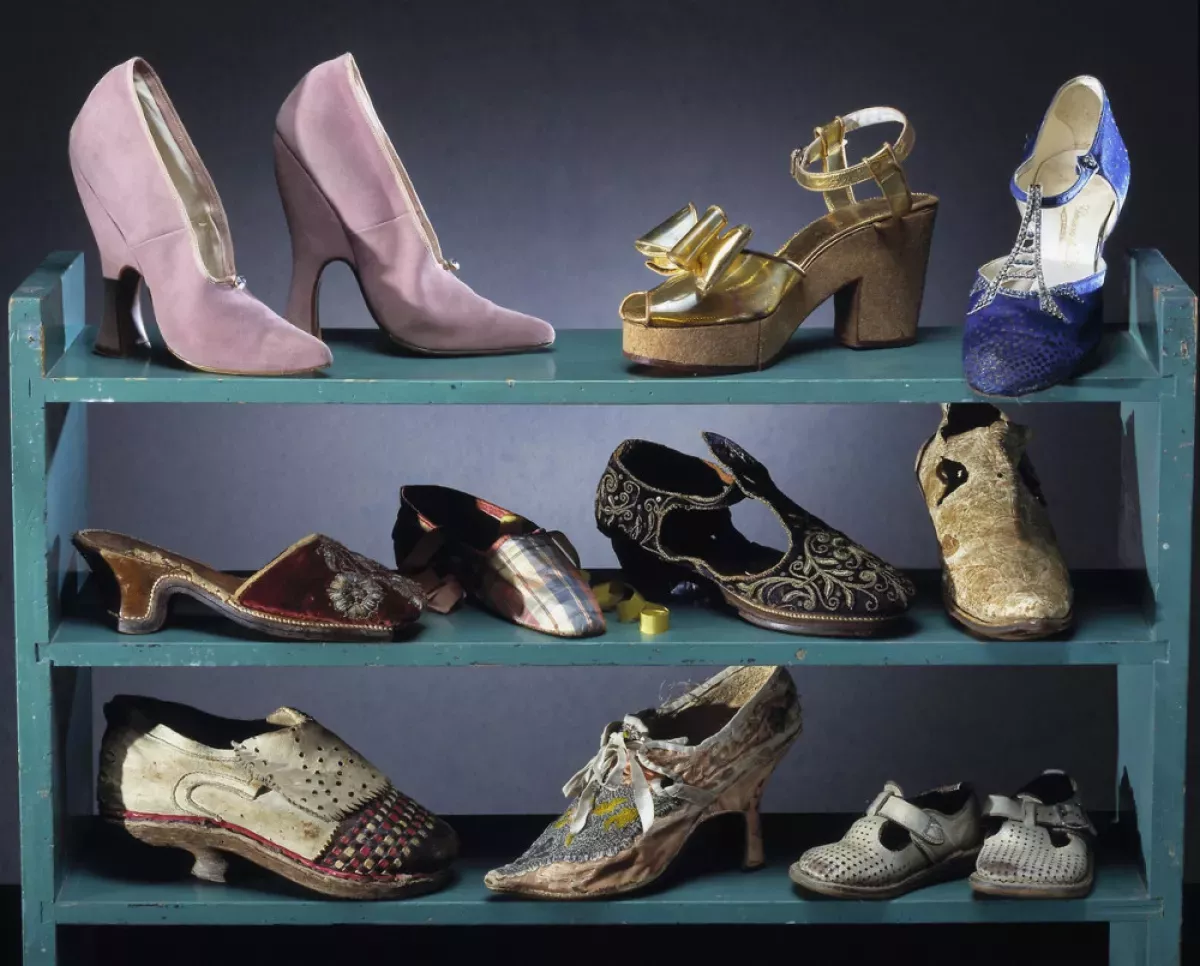A shoe is a protective and comfort-providing item of footwear designed for the human foot. While the foot is adaptable, it's also vulnerable, necessitating protection that shoes offer. Originally functional, shoes have evolved to become fashion items as well. Certain types serve as safety equipment, exemplified by steel-toe boots used in industrial settings to prevent foot injuries. Shoes vary widely, reflecting both practical needs and cultural trends.
1902: Ban on foot binding implemented
In 1902, a ban on foot binding was implemented in China, but it was soon repealed.
1910: Development of AGO shoe manufacturing process
In 1910, a process for manufacturing stitchless, that is, glued, shoes—AGO—was developed.
1911: Foot binding banned again
In 1911, the new Nationalist government in China banned foot binding again. It was effective in coastal cities, but countryside cities continued without much regulation.
1916: Consolidation of rubber-soled shoe brands under Keds
In 1916, the United States Rubber Company consolidated its rubber-soled and heeled shoe brands under the name Keds, and these shoes became known as "sneakers".
1938: Sagebrush bark sandals found in Oregon
In 1938, the earliest known shoes, sagebrush bark sandals dating from approximately 7000 or 8000 BC, were found in the Fort Rock Cave in Oregon.
1948: Construction of the Haines Shoe House
In 1948, Mahlon Haines, a shoe salesman in Hallam, Pennsylvania, built the Haines Shoe House, an actual house shaped like a work boot, as a form of advertisement.
1949: Mao Zedong enforces foot binding ban
In 1949, Mao Zedong enforced the rule against foot binding in China, and the practice is still forbidden.
1964: Founding of Nike
In 1964, Nike was founded by Phil Knight and Bill Bowerman of the University of Oregon, introducing many new improvements common in modern running shoes.
1968: Puma introduces sneakers with Velcro straps
In 1968, Puma SE introduced the first pair of sneakers with Velcro straps in lieu of shoelaces, and these became popular by the 1980s.
1969: Chuck Taylor inducted into the Naismith Memorial Basketball Hall of Fame
In 1969, Chuck Taylor was inducted into the Naismith Memorial Basketball Hall of Fame in recognition of his development of shoes specific to the sport of basketball, known as Chuck Taylor All-Stars.
1973: Introduction of Mondopoint system
In 1973, International Standard ISO 2816:1973 "Fundamental characteristics of a system of shoe sizing to be known as Mondopoint" was introduced, which includes measurements of both length and width of the foot.
1975: Shoe sizes – System of length grading
In 1975, ISO 3355:1975 "Shoe sizes – System of length grading (for use in the Mondopoint system)" was released.
April 1985: Nike introduces Air Jordan
In April 1985, Nike introduced its own brand of basketball shoe, the Air Jordan, named after Michael Jordan. The Air Jordan line of shoes sold $100 million in their first year.
1985: Release of The Man with One Red Shoe
In 1985, the comedy movie "The Man with One Red Shoe" was released, featuring an eccentric man wearing one normal business shoe and one red shoe that becomes central to the plot.
2003: Iraqis strike Saddam Hussein's statue with shoes
In 2003, after Saddam Hussein's statue was toppled in Iraq, Iraqis gathered around it and struck the statue with their shoes as a sign of insult.
August 2006: Discovery of the Jotunheimen shoe
In August 2006, the Jotunheimen shoe was discovered. Archaeologists estimate that this leather shoe was made between 1800 and 1100 BC, making it the oldest article of clothing discovered in Scandinavia.
2007: Global shoe industry market size
In 2007, the global shoe industry had an overall market of $107.4 billion in terms of revenue.
2008: Shoe thrown at George W. Bush
In 2008, United States President George W. Bush had a shoe thrown at him by a journalist as a statement against the war in Iraq.
2008: World's oldest leather shoe found in Armenia
In 2008, the world's oldest leather shoe, made from a single piece of cowhide laced with a leather cord, was found in the Areni-1 cave complex in Armenia and is believed to date to 3500 BC.
2012: Expected growth of the global shoe industry
By the end of 2012, the global shoe industry was expected to grow to $122.9 billion.
2023: Sandals found in Spain
In 2023, Sandals and other plant fiber based tools were found in Cueva de los Murciélagos in Albuñol in southern Spain, dating to approximately 7500 to 4200 BC, making them what are believed to be the oldest shoes found in Europe.
Mentioned in this timeline

Basketball is a team sport played on a rectangular court...

Michael Jordan often known as MJ is a businessman and...

George W Bush the rd U S President - is...
China officially the People's Republic of China PRC is an...
Pennsylvania is a U S state located in the Mid-Atlantic...
Iraq officially the Republic of Iraq is a West Asian...
Trending

7 months ago Michelle Obama Reveals Barack's Joke After Her Mother's Death and Pope's Viewing Habits.

Tony Dow was a renowned American actor producer director and sculptor best known for his role as Wally Cleaver in...
2 months ago IREN Stock Surges on AI Cloud Deals and Bitcoin Mining Integration.
10 days ago Lawsuit Filed Over KISD Stabbing; Killeen Principal Resigns From Ira Cross
7 months ago Josh Bell's Big Night: Solo Homer and Multi-Hit Game ignite Hopes

1 month ago Yungblud teams with Aerosmith for Rolling Stone UK cover; concert and rock relationship.
Popular

Candace Owens is an American conservative political commentator and author...

Ilhan Omar is an American politician currently serving as the...

XXXTentacion born Jahseh Dwayne Ricardo Onfroy was a controversial yet...

Oprah Winfrey an American talk show host television producer actress...

Tom Cotton is an American politician and Army veteran currently...

Frederick Christ Trump Sr - was an American real estate...

